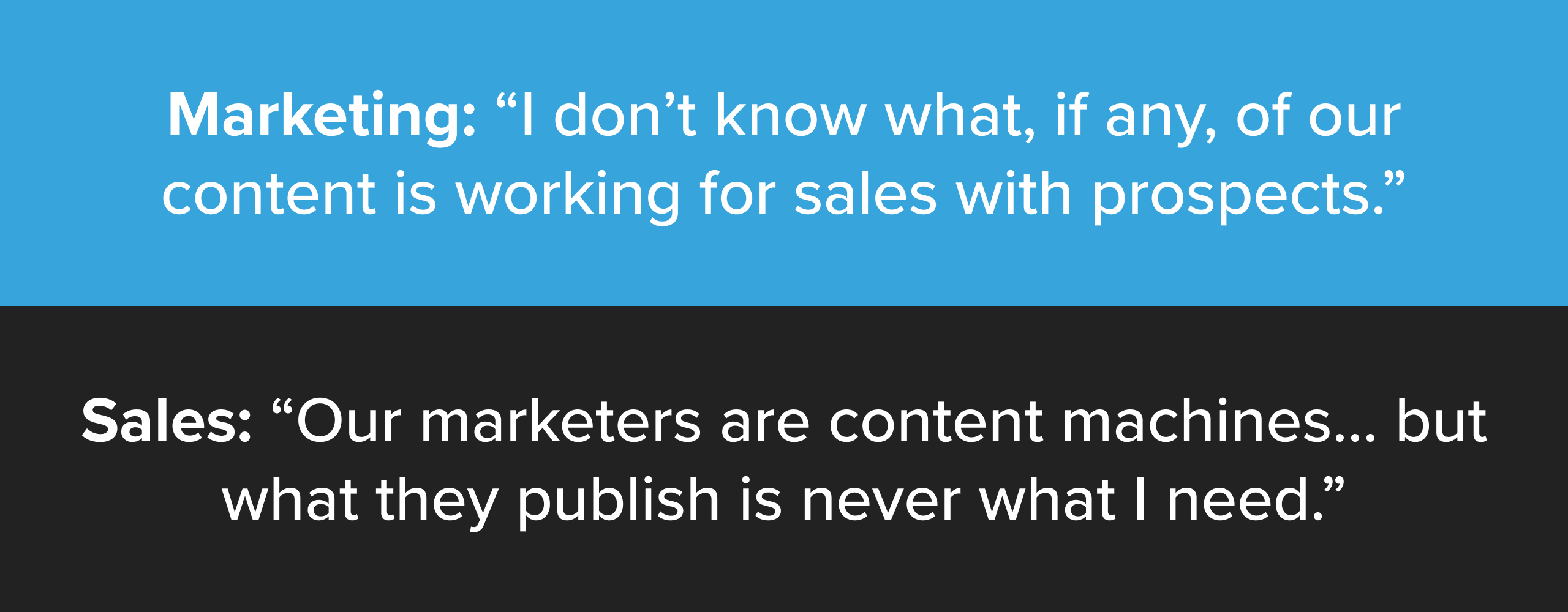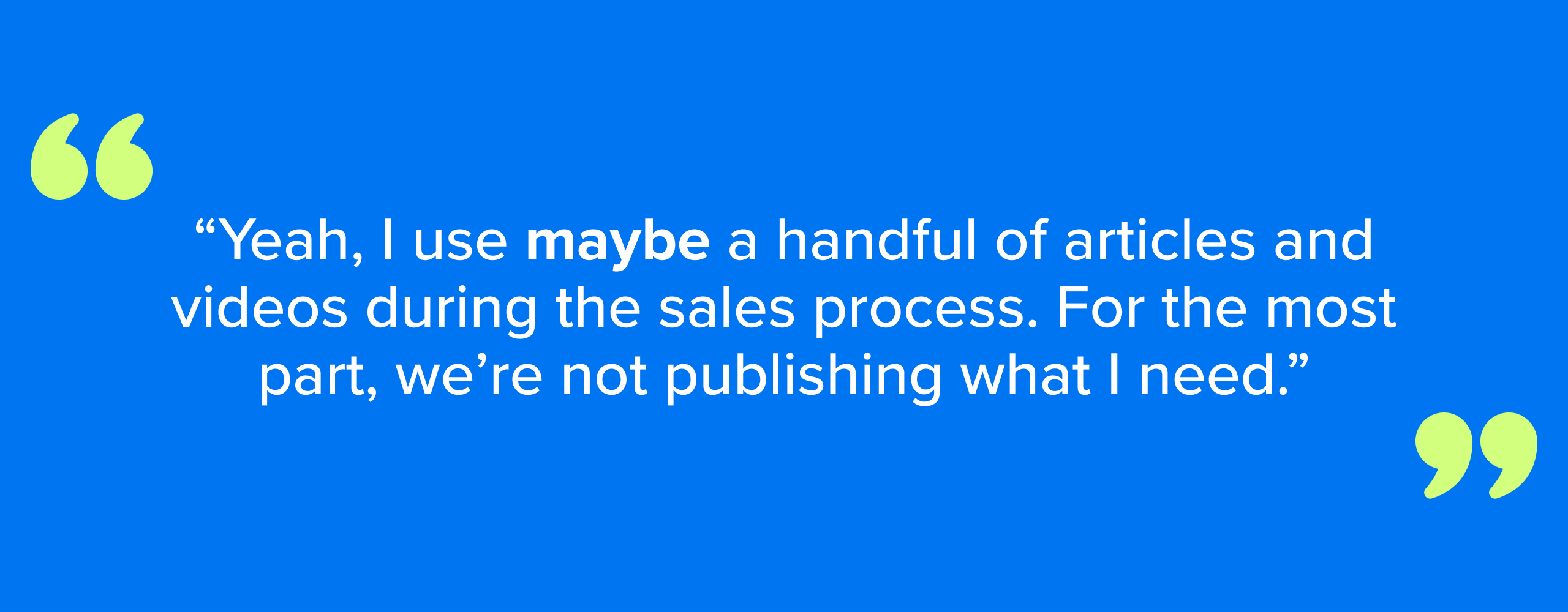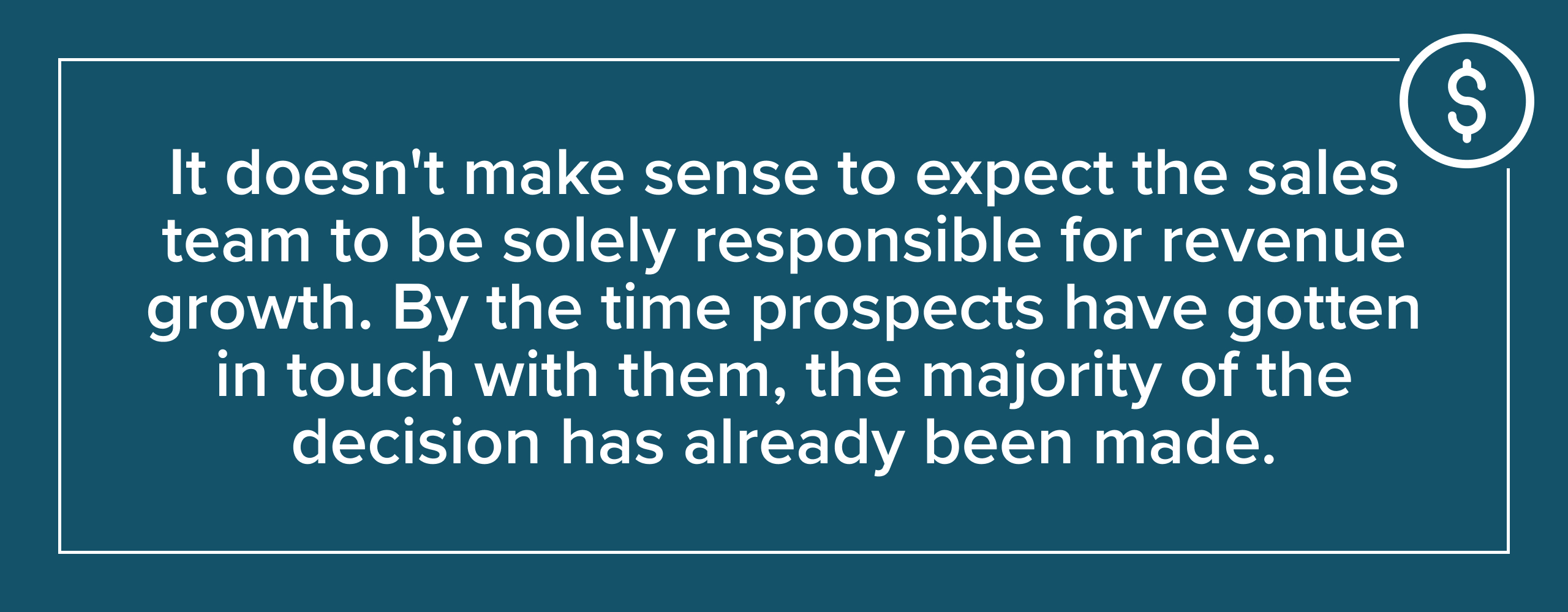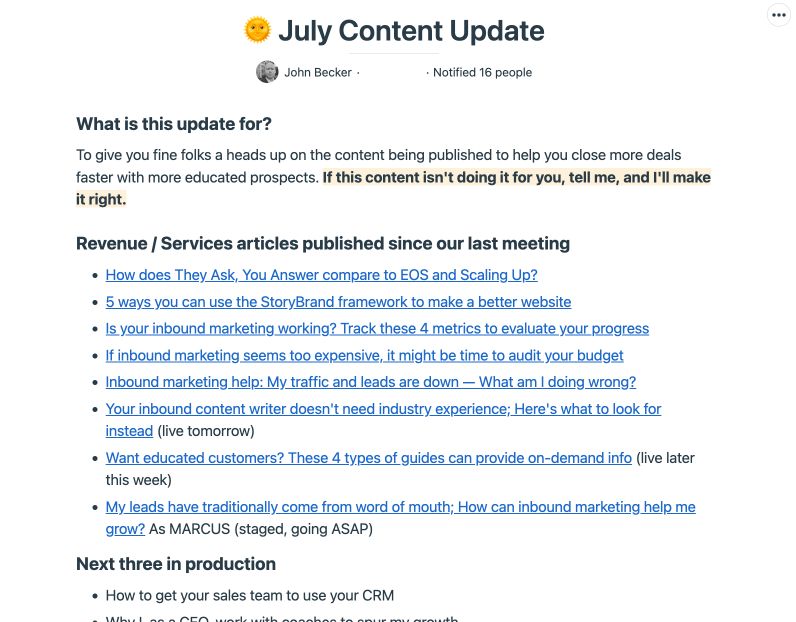Topics:
Content Marketing Sales & Marketing Alignment Content Managers Content and Inbound Marketing 101 Sales EnablementSubscribe now and get the latest podcast releases delivered straight to your inbox.
How To Create Sales Enablement Content Your Sales Team Will Love

By John Becker
Aug 17, 2023

How to create sales enablement content
- Form a revenue team with key stakeholders from your sales and marketing teams
- Schedule weekly or biweekly revenue team meetings
- During those meetings, facilitate a revenue content brainstorm by asking, "What questions are you currently being asked by buyers in the sales process that should have a piece of content created for it?"
- Use the sales enablement content tool during that brainstorm (and encourage its use all the time between brainstorms)
- Publish your sales enablement content at a rate of two to four pieces per week
- Share regular updates with your revenue team of what's been published, what's in the pipeline, and the state of video production
Let’s pull the bandaid off and get it all out there: Sales and marketing alignment is damn-near impossible. And honestly, I can totally see why.
Although inbound marketing promises a utopia of sales and marketing synergy, many organizations don’t see that actually materialize.
Instead, it can seem like your sales and marketing teams aren’t even speaking the same language. How could they ever possibly see eye to eye?
A common sticking point in this age-old clash is content: A marketing department creates the blogs, videos, webpages, buyer’s guides, and more — and the sales team needs to use these assets with prospects. But instead of cooperation and teamwork, there’s confusion and frustration.

But never fear. Our focus today is all about how to come together and create the sales enablement content that sales teams love, buyers need, and marketers can feel good about.
Below, I’ll dive into:
- How to bring your teams together to get the content you need
- Tools we use at IMPACT to create sales enablement content
- Building a sales enablement culture at your organization
This is something that everybody faces
I always find myself intensely skeptical of people who say they don’t struggle with the problems other people face.
And so, I think it’s important to be honest here. Yes, IMPACT trains businesses all over the world to master sales enablement, but, at the same time, we’ve struggled in the past with sales enablement in our own business.
IMPACT definitely had those problems that everyone complains about.
Our inbound marketing team was creating lots of content, and sales found very little of it useful when talking to prospects.

It's time to take a long look in the mirror. It's time to bite the bullet and bring your sales and marketing teams together. The effect of on-target sales enablement content will be well worth the scant time you give up to meet.
I promise.
4 steps to sales enablement success
If you're a marketer who is struggling to create content your sales team finds valuable, this post is for you. While I know every organization is different, the tactics shared below should be universal.
Below, you’ll find step-by-step instructions. If you follow them, I guarantee you'll have your sales team singing your praises and closing more deals.
The first step is turning two teams into one.
1. Form a 'revenue team' at your company
That's right, your first step has nothing to do with creating content, looking at content, or (quite frankly) anything to do with content at all.
Instead, you need to understand that your sales team finding your marketing content useless is not the problem — it is a symptom of a much larger problem.
Now that buyers (just like you and me) turn to the internet for our purchasing decision research, rather than talking to sales teams directly (like we used to), the way marketing and sales teams have traditionally functioned no longer works.
It doesn't make sense to expect the sales team to be solely responsible for revenue growth. By the time prospects have gotten in touch with them, the majority of the decision has already been made.

But marketing shouldn't be solely responsible for revenue either.
When you bring the teams together, you ensure a better customer experience because the marketing content and the sales process will be connected.
You solve this by creating a revenue team.
A revenue team is made of stakeholders from your sales and marketing teams — your content marketing manager, the head of marketing, the head of sales, your entire sales team, and so on. Together, they focus on a shared goal of increasing revenue through traffic, leads, and sales.
Instead of two competing teams with independent priorities, the members of this singular unit work together to achieve their mutual goal of revenue growth through collaboration, information-sharing, brainstorming, and problem-solving.
Admittedly, this first step is a big one. You need institutional buy-in to change team structure. You need shared meeting time, shared objectives, and more.
But the payoff is worth it.
2. Facilitate revenue team content brainstorms (weekly or biweekly)
The key to creating content your sales team will love is simple: You need your sales team’s help. If they’re involved in the process, you’ll end up with the content they actually want and need.
This is critically important. If you're just getting started in content marketing, you might think you need to chase traffic and go viral. If you really want to help your company, make content that will help close deals by answering prospects’ questions.

This is done through a proven advanced sales technique called assignment selling.
It's with this in mind that you will facilitate content brainstorms as part of a weekly or biweekly revenue team meeting, with the following agenda:
- Go over what assignment selling content (written and video) has been published since your last meeting
- Go over what assignment selling content (written and video) is currently in the production pipeline
- Discuss how previously published assignment selling content (written and video) has been performing for sales
- Ask the sales team: "What questions are you currently being asked by buyers in the sales process that should have a piece of content created to answer them?"
The last question, which is bolded, is where your sales enablement content magic will happen. The answers you receive to that question from your sales team should make up the bulk of your editorial calendar.
If you're struggling to get great answers
Sometimes you need to restate the question in different ways if you find that your sales folks are struggling to think of good questions for content.
Here are a few ways you can restate this question in a way that will yield even more ideas for great sales enablement content:
- What questions do you get asked that immediately indicate the buyer is not close to ready to make a decision?
- What do your clients and buyers push back on the most?
- What are your buyer's biggest doubts or worries (with respect to the product, the process, the company)?
- What do your buyers have to convince the key decision-makers of?
Ask the right follow-up questions of your sales folks
The quality of your sales enablement content will be dependent on the quality and validity of the original question you're answering.

So, whenever I'm facilitating a content brainstorm for our team at IMPACT, I use these follow-up questions with every single suggestion the sales team makes:
- Is this the exact question being asked, in the words of the prospect? Or have you reworded it in any way, based on what you know the actual problem is? (Hint: It should always be in the words of the prospect.)
- Why are they asking this question? Did they ask this proactively? Or is it in response to something we told them, asked them to do, etc.? Is it a question in response to us saying no to something?
- When are they asking this question during the sales process? Is it always at a particular stage of the sales process? Is there no specific time, just a general question that comes up randomly?
- What is the question specifically about? Our sales process? A specific product? (Meaning, does this question need to be answered multiple times across multiple pieces of content for each product/service?) Or is it just about working with us in general?
- Will this piece of content make a difference? If you're going to take time to write or film it, the payoff should be worth it.
When we first started doing content brainstorms, I had to ask these questions a lot. (The sales team didn't push back at all, by the way. They saw and understood the value of the questions.)
Now, I don't have to do that as much, because they've trained themselves to think with this audience-focused mindset.
Use this sales enablement content brainstorm tool
To facilitate brainstorming, I created this sales content sandbox tool you're welcome to use:
Here's how it works:
First, suggestions are entered with the following information: The topic is phrased as a question in the words of the buyer, whether or not they want it as a blog article, a video, or both: who is making the request from sales, their ideal subject matter expert to address the topic, and why the topic is being requested.
Next, sales team members can denote priority by "upvoting" topics, and the spreadsheet will automatically sort the topics with the highest votes to the top!
I like automated things.
Also, as appropriate, the color of the rows will be updated based on the status column. Again, it makes it easy for people to understand visually where everything stands without a lot of hands-on work.
The key with this tool is that it's not just used during the brainstorm itself — it should be used by the sales team all the time.
We developed the tool so sales team members could communicate revenue team content priorities in real-time, as ideas came up. So, if there’s something that comes up between brainstorm meetings, the salesperson can put it in the spreadsheet.
They can also check the status of any content that’s in production.
3. Publish the content
Okay, so this step is easy. Once you know what you're supposed to be writing about, you need to:
- Interview the subject matter experts to get the insights you need to produce the content. (Or, if you don't need to interview anyone, sit down and crank those babies out.)
- Publish the content at a cadence of two to three pieces of new content a week. (Three to four is the ideal, but two to three is a great place to start.)
If these pieces of revenue content will be layered into a larger content strategy — that's how it is at IMPACT, because we publish a lot — I'd recommend strongly tagging every single sales enablement article in your marketing automation platform with a shared campaign.
For example, we tag all of our assignment selling content from our content strategy with a "revenue content strategy" campaign in HubSpot.
If you want, you can also use a tool like Paperflite or Salesreach to organize and track engagement with your content.
4. Let your sales team know when marketing materials go live
Your sales professionals are super, super busy. They're going to miss it when things get published.
Moreover, if you want to build trust between your marketing team and sales, you need to go out of your way to show that the needs of your sales team are a priority to you — and that you're going to keep your promise of publishing the content they need.
So, on a weekly or biweekly basis (I'd recommend the day before your content brainstorm, so you can review it as part of the agenda I outlined above), you should send out a content update to the entire revenue team.
At IMPACT, we use Basecamp for asynchronous communication. Here is a real-life example of a revenue content update I've sent out to our team:

I open it with an overview of what the update is and the most recently published revenue content strategy pieces. (For each, I like to include context, use cases, and perceived value.)
Then, I give a preview of what's coming down the pipeline, with estimated dates of publication, although they are sometimes subject to change.
I also do the same for video, so folks know what's been published, what's coming, and what we're working on.
Make the commitment to sales
Listen, content marketers: If you treat what I've shared here as a small "check the box" item on your to-do list, you will fail.
You have to let go of the "us vs. them" mentality that has plagued sales and marketing teams all over the world for decades. You must go out of your way to prove to sales that you're ready to do what's necessary to empower them to hit their goals.
You also need to see that "their" goals are actually your goals, too.
From personal experience, I cannot tell you how rewarding it is to sit on revenue team meetings and hear our sales team say they feel they're actually being given the materials, content, blogs, and videos, they need to close more deals faster.
You can have that feeling at your own company, too. But it begins with a commitment. It begins with you understanding that what I'm suggesting here is more than just embracing a new content strategy. It's a new way of thinking about how your sales and marketing teams work together.
Not sure if you can do all this on your own? Talk to IMPACT. Every day, we help businesses like yours unite their sales and marketing efforts to drive more revenue.


Order Your Copy of Marcus Sheridan's New Book — Endless Customers!